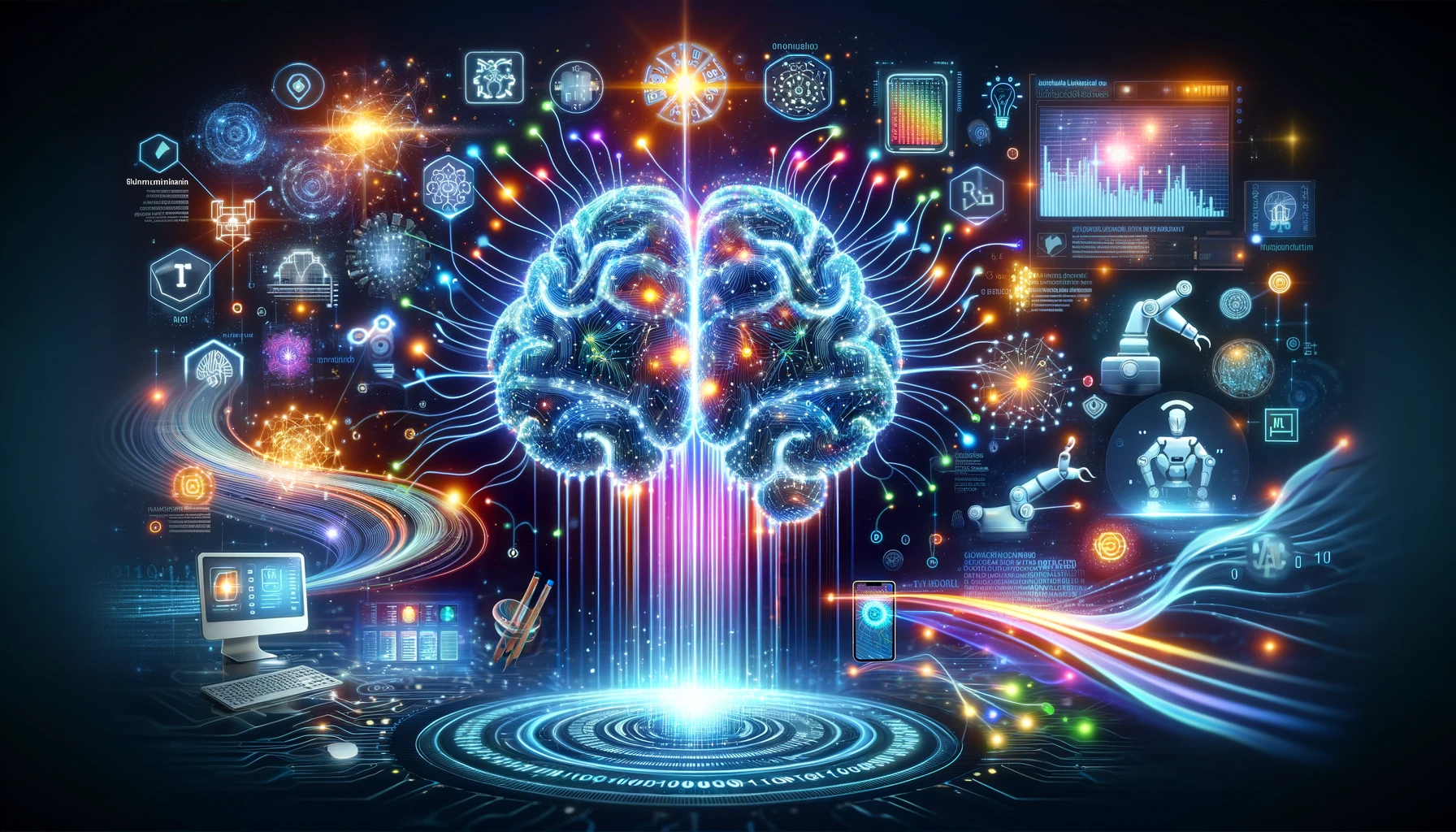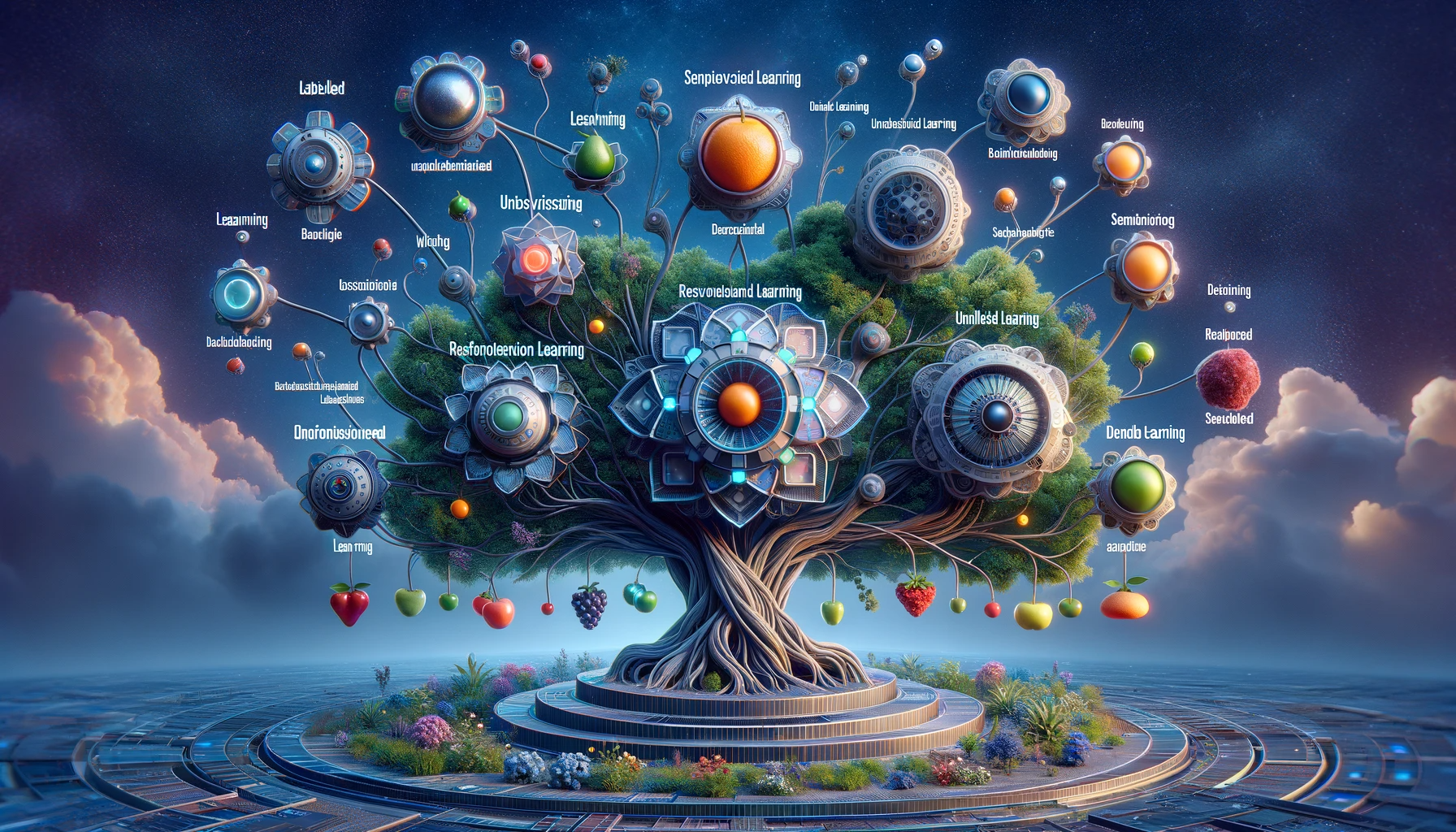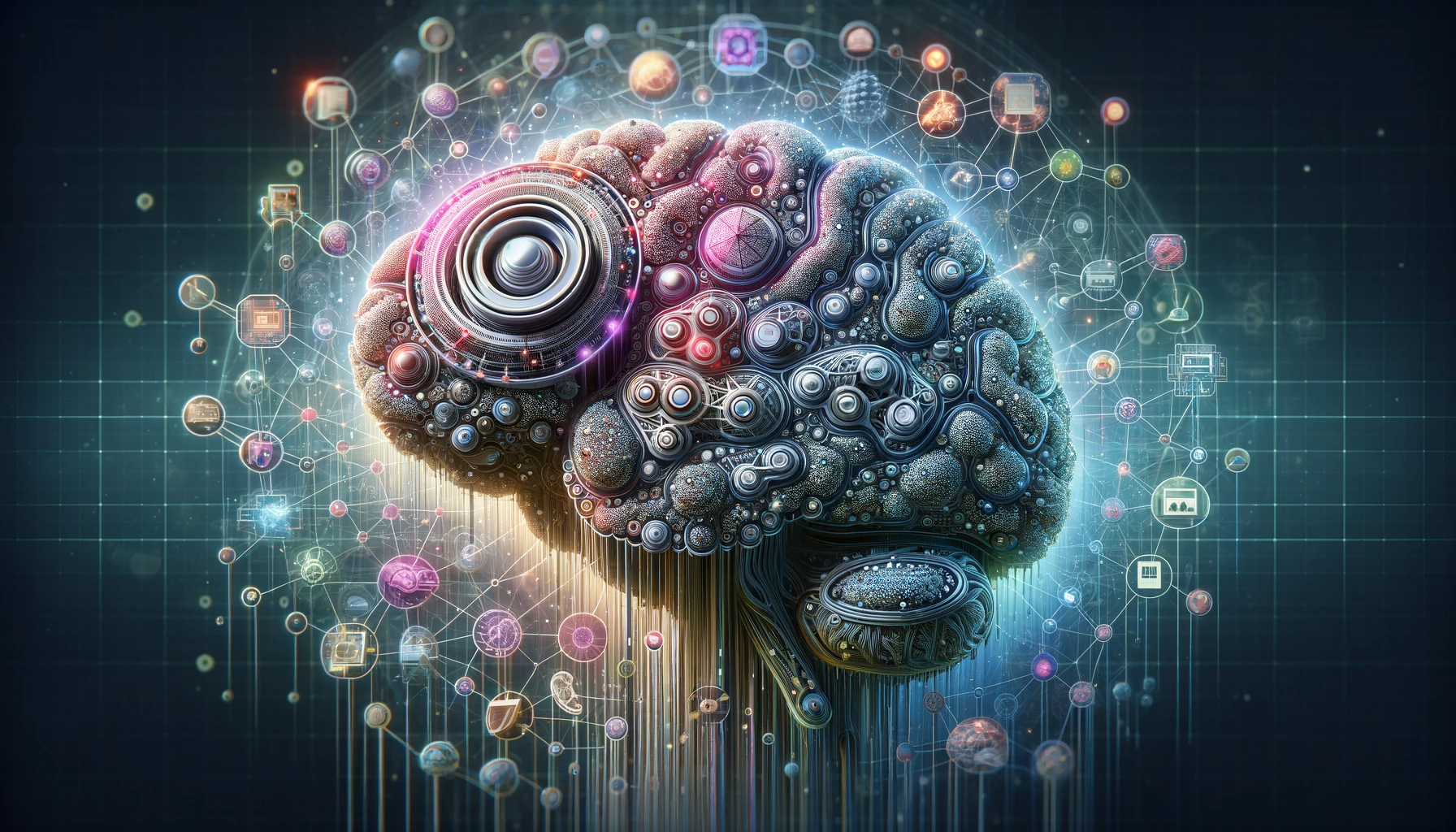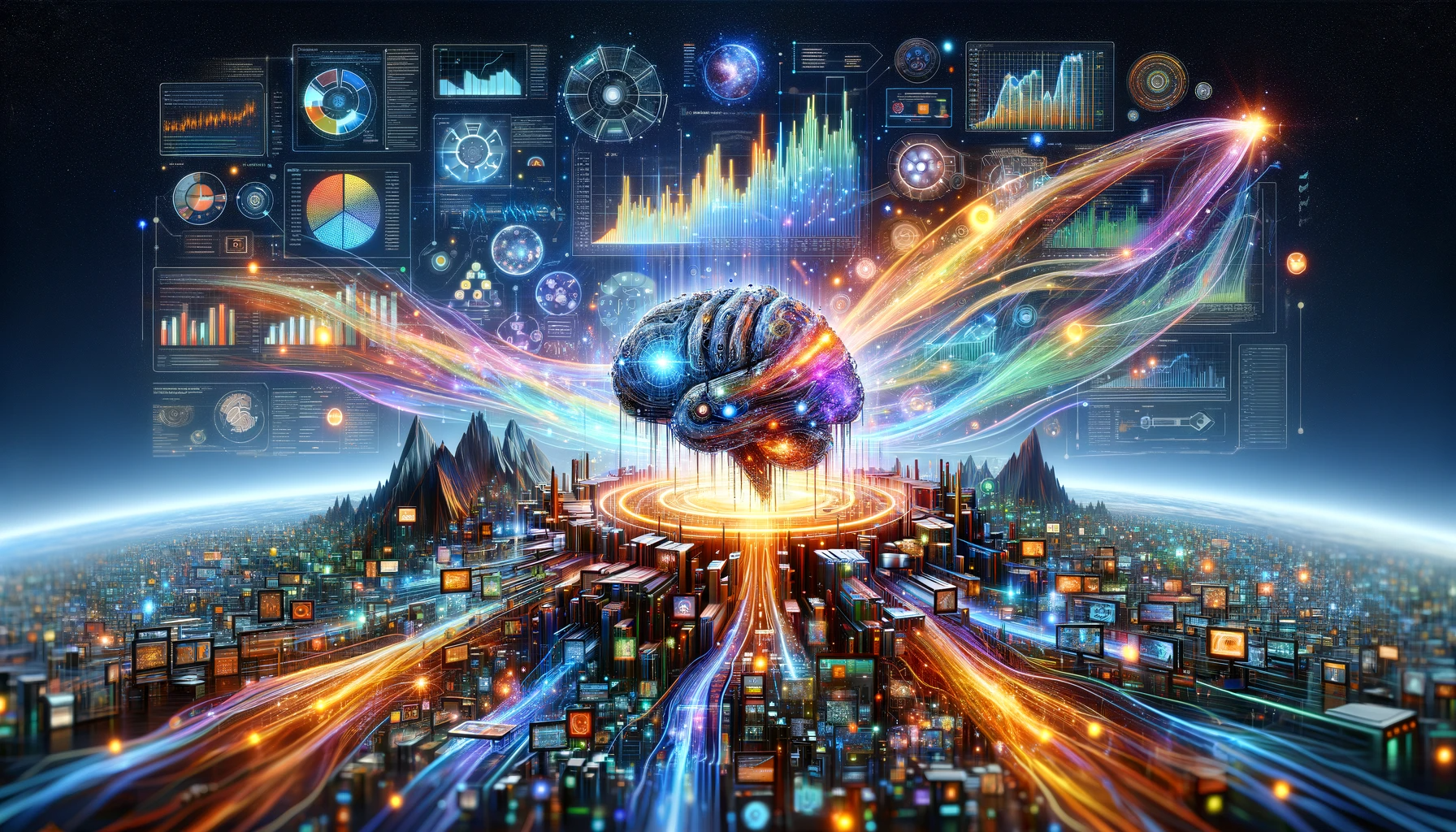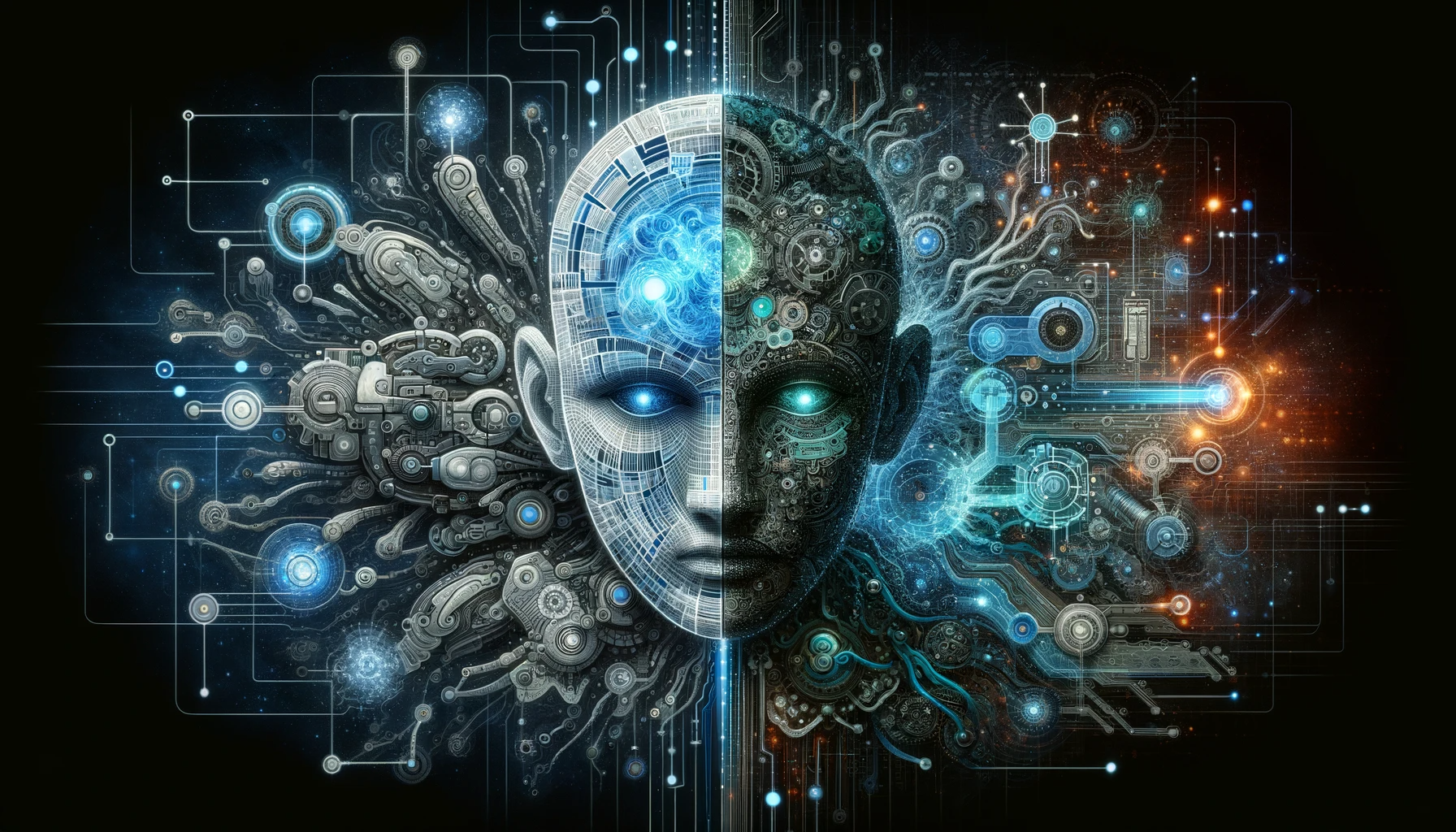Machine learning, incorporating supervised, unsupervised, and reinforcement models, significantly enhances data analysis and industry practices. It plays a crucial role in deciphering complex data, provides insights across sectors, and features both advantages and challenges in its applications.
What Is Machine Learning in the World of Artificial Intelligence?
Machine learning (ML) is a dynamic and thrilling corner of artificial intelligence (AI) that's all about crafting technology that can learn from experience. We're talkin' about a form of AI that's not just smart, but it gets smarter the more data it chews on. See, unlike traditional software that remains as static as a statue, ML-equipped systems are trained to dig through heaps of data and improve over time. It's like having a digital buddy that grows wiser with every interaction. This intersection where artificial intelligence meets learning is what makes ML shine—it's the whiz kid of the AI Tools family.
The beauty of machine learning lies in its versatility! Whether it's crunching numbers or spotting patterns, ML's got a knack for it. But don't get it twisted; it's not all about cold calculations. ML models can be intelligent companions in our everyday lives, helping us make sense of complex decisions with ease. From personalized recommendations to nailing predictive text, this intelligent technology keeps things convenient and efficient. It's like ML whispers to our machines, "Hey, let's be extra intelligent today."
Now, diving into the types of learning ML can handle, we've got the whole gang: supervised, unsupervised, and reinforcement learning—each with its unique approach to becoming more intelligent over time. Want to predict what's gonna happen next based on past events? You've got your supervised learning. Want to discover hidden patterns without any hand-holding? Unsupervised learning's got your back. And when you need a technology that learns through trial and error, reinforcement learning steps into the ring, all trained and ready to rumble. Machine learning, like a brainy sponge, keeps absorbing info and learning, making our smart world an endless loop of evolving intelligence.
Understanding Machine Learning: Definition and Importance
Digging into the core of artificial intelligence, we find machine learning (ML) at its beating heart. It's the driving force that's redefining how we interact with technology. The definition of ML revolves around a concept that might seem like sci-fi but is very much a reality — giving machines the ability to learn and adapt. This process involves feeding data into algorithms (yes, those repetitive keywords point out just how central algorithms are in ML). There's a constant feedback loop where these algorithms learn from data to make decisions or predictions.
The importance of ML can't be overstated. From email filtering to voice recognition, the applications are becoming ingrained in our daily lives. But understanding machine learning goes beyond recognizing its end uses. It's about comprehending the nuts and bolts, that is, the learning part. There are several types of learning within ML, each with its unique approach: supervised, unsupervised, and reinforcement learning. These aren't just time-passers; they're the building blocks for developing intelligent systems that can mimic human learning.
Let's talk about the types of learning because, well, learning is crucial in ML! Each brings its flavor to the table, crafting tailored algorithms that thrive on various data diets. It's not just about feeding the algorithms; it's about nurturing them. They crunch, analyze, and evolve from each byte they consume. This incessant learning cycle is what sets ML apart and why it's vital to grasp not just what machine learning is but why it's such a game-changer in tech and beyond. As we continue to uncover the layers, ML remains a field of endless possibilities, especially as we've moved into 2022.
Exploring the Different Types of Machine Learning Models
Diving into the realm of machine learning is like opening a Pandora's box of technological advancements; it's complex, yet utterly fascinating. At the very core of these learning systems are models that are broadly grouped into categories like supervised, unsupervised, and even semi-supervised, each with unique capabilities and suited for various types of datasets. Now, supervised learning is probably what pops into your head when you think of machine learning – it's all about those systems that need labeled datasets to train on. They're like students who learn under the guidance of a teacher, the label acting as the correct answer.
Unsupervised learning, on the flip side, is the wild child of machine learning models. These systems are like explorers, diving into unlabeled datasets and looking for hidden structures or patterns. They don't need a teacher; their learning process is self-guided as they make sense of the data they're given. Reinforcement learning, often left out of the conversation, is another critical type. It's like training a pet — the system learns to perform tasks through rewards and penalties.
Each type of model has its place in the grand tapestry of machine learning applications. From recommendation engines that harness unsupervised learning to predict your next favorite Netflix show, to medical diagnosis systems empowered by supervised learning to enhance accuracy, these models are reshaping our understanding of what's possible. And, let's not forget the semi-supervised models that combine a bit of both worlds!
While the essence of these learning systems remains constant, their evolution is never-ending. The future's looking bright – or should we say, intelligently automated – thanks to these smart systems adapting to a myriad of datasets, constantly learning and improving over time.
Deep Learning as a Subset of Machine Learning
Diving into the intricate world of artificial intelligence, it's impossible not to stumble upon the fascinating realm of deep learning. As a crucial subset of machine learning, deep learning takes inspiration from the human brain, utilizing layers upon layers of neural networks to digest massive amounts of data. These neural networks are like virtual neurons, intricately connected in a way that mimics our noggins. What sets deep learning apart is its profound ability to learn and make decisions without human intervention, constantly improving from experience and becoming more efficient at tasks ranging from speech recognition to autonomous driving. Neural networks, you see, are the backbone of deep learning. They're complex, adaptive systems where each 'neuron' links to many others, creating a sprawling web of connections where information zips around like cars on a superhighway.
It's the depth of these neural layers that enables deep learning to outshine other machine learning techniques, especially when it comes to parsing unstructured data that's more intuitive than logical. Let's not forget, neural networks thrive on data—the more, the merrier. As they gobble up data, neural networks refine their algorithms, deepening their understanding and improving their accuracy. The 'deep' in deep learning is no joke; it implies a profound level of computation that can often seem almost, dare I say, introspective. And neural networks don't stop at just one layer. Oh no, they stack them deep, constructing complex architectures that can learn from data in a way that's both intricate and elegant. Deep learning, therefore, isn't just a part of machine learning—it's a trailblazing pathway that often leads to ground-breaking advancements in AI. Machine learning might be the broad church where algorithms are born, but deep learning is the chapel where the neural faithful congregate, committing to deeper understanding and richer applications.
How Machine Learning is Revolutionizing Data Analysis
Imagine a world where data analysis isn't just a task but a dynamic journey that's constantly evolving. That's the kind of world machine learning is fashioning for us today. It's not just an aspect of data science; it's the backbone that's transforming how we look at zettabytes upon zettabytes of data. You see, machine learning is like this super-smart buddy who sifts through heaps of data, picks out what's interesting, and gives us the low-down in a way that makes sense. It's revolutionizing the game by harnessing algorithms that learn from data, automatically. And it's not just any ol' data – this data could be numbers, words, images, clicks – you name it! What's wild is that machine learning isn't sticking to one lane; it's all over the place – in the best way possible.
From financial forecasting to social media filters, this beast is the heart of countless applications. Its ability to relentlessly crunch data, find patterns, and dish out predictions is second to none. But let's not get it twisted – it goes way beyond simple automation and number-crunching. With its predictive powers, machine learning's helping us to make decisions that are loads smarter, swifter, and savvier, giving a massive boost to the realm of data science. Diving a bit deeper, machine learning's muscle comes in different forms, with each type tailored to conquer a unique slice of the data pie.
Picture supervised learning as the diligent student, always learning from labeled data, while unsupervised learning is like the maverick, finding hidden structures in data without being told what to look for. And then there's the brainiac of the bunch – deep learning – diving into complex data sets with a gusto that's nothing short of inspiring. It's clear as day; machine learning isn't just revolutionizing data analysis – it's remaking the way we interact with the world of data at every turn.
The Connection Between Machine Learning and Big Data
When we dive into the world of machine learning, it's like uncovering a treasure trove of possibilities that can be harnessed from big data. Think of machine learning as the savvy friend that can make sense of an enormous pile of jigsaw puzzle pieces. It's the connection here that really spices things up; machine learning algorithms thrive on vast datasets - the more information they can chow down on, the more they can learn. This learning process is continuous, forming an almost symbiotic relationship with data. It's a give-and-take scenario: big data feeds machine learning, and as a reward, machine learning models grow smarter, enabling them to deliver more accurate predictions and insights.
This tireless cycle of learning, refining, and applying is what makes machine learning an indispensable tool in our digital age. With each iteration, these algorithms get better at identifying patterns and making decisions - skills that are crucial when you're dealing with big data. We've been chatting about various aspects of machine learning, from understanding its core definition to exploring the different types of machine learning models, and making a pit stop at the powerhouse of deep learning as a subset. Each aspect underlines the cruciality of the connection between machine learning and big data.
As we've seen throughout this article, machine learning isn't just revolutionizing data analysis; it's redrawing the boundaries of what's possible in technology and business. Whether it's through predictive analytics, enhancing customer experiences, or automating tedious tasks, the connection with big data is streaming a world of opportunities into reality. The marriage of machine learning and big data is a match made in data heaven, and it's reshaping our future—one learning moment at a time.
Machine Learning and AI: How They Work Together
When we dive into the tech universe, it's no secret that machine learning and AI (artificial intelligence) are like two peas in a pod; they're virtually inseparable and work together like a dream. So, how do they do it? Well, machine learning is the brainy whiz-kid that empowers AI with the ability to learn on the fly. Picture it: AI tools painstakingly picking up patterns and insights, with machine learning algorithms acting like personal trainers, pushing AI's 'muscles'—its intelligence, to get stronger and smarter.
Together, these two fields create a powerhouse that's shaking up the way we live and work. Think of AI as the overarching genius that brings cool ideas to life, while machine learning is the nuts and bolts making it happen. In the grand scheme of things, AI wouldn't be quite as artificially spectacular without the smarts of machine learning models. It's this dynamic duo that's behind everything from those recommendations you get on streaming services to self-driving tech that's beginning to cruise our streets.
But let's not forget, AI and machine learning aren't just two trending buzzwords; they've got substance. They're revolutionizing data analysis and giving big data the breakthrough it desperately needed. By crunching vast amounts of information, machine learning helps AI distinguish what's important. In other words, machine learning is the sponge soaking up knowledge, and AI is the brain putting it all to good use. So when we're chatting about how AI and machine learning work together, we're really talking about a partnership that's transforming artificial intelligence into something that's starting to look and feel a lot like human intelligence.
Why Machine Learning Matters in the Age of AI
In today's tech-driven world, machine learning is the heart that keeps the body of AI running smoothly, making it undeniably significant. It's not just some fancy buzzword; it's the very essence that gives artificial intelligence a leg to stand on, enabling systems to learn from data, improve from experience, and make smart decisions without explicit programming. This importance has only amplified in the age where digital transformation is king, and adapting to ever-evolving technologies is quintessential for staying afloat and ahead. The machine in 'machine learning' refers to an ensemble of computational models that refine their outputs as they chew through more information – and believe me, in an era where data is the new oil, there's a barrel-load to process!
Why does machine learning matter, you ask? Well, think of every smart gadget you've got, every savvy app you rely on; they're all embedded with bits of intelligence—thank machine learning for that. It's like the secret ingredient that amps up a good meal to a great one. Businesses, healthcare, finance, you name it—they're all leveraging machine learning to optimize operations and deliver personalized experiences. It's transforming the mundane into the extraordinary, ensuring machines can tackle tasks that once needed hefty human intelligence.
So, let's toast to machine learning for making sure our friendly neighbourhood AI gets smarter, faster, and way more competent. In essence, it's all about embedding that crisp layer of intelligence into systems we interact with daily. Do we owe it all to some hidden team of mad geniuses? Nope, it's all thanks to the clever folks and their passion for innovation at places like Machine Labs AI, because they're the ones turning the gears, ensuring this powerful blend of machine smarts and intelligence keeps evolving. That's why it matters. As we scoop up bucketloads of data in this digital age, machine learning is the wizardry that turns that data into gold—AI gold, to be precise.
The Pivotal Role of Machine Learning in AI
- Core Driver of AI: Machine learning is the foundational technology that powers the functionality and intelligence of AI systems.
- Data Processing Mastery: Handles massive volumes of data, transforming it into actionable insights and intelligent decisions.
- Enhancing Everyday Tech: Integral to the smart features in gadgets and applications, elevating user experience and efficiency.
- Business & Healthcare Revolution: A key player in optimizing operations and personalizing experiences across diverse sectors.
- Continuous Evolution: Facilitates the constant advancement of AI, adapting to technological changes and new data patterns.
- Innovation Catalyst: Driven by creative minds and technological passion, machine learning is the engine behind AI's ongoing development.
- Transforming Data into AI Gold: Converts vast data resources into valuable intelligence, underscoring its critical role in the digital era.
Machine Learning in Action: Real-World Applications
Have you ever wondered about the power of machine learning and how it's taking the world of AI by storm? It's pretty much everywhere, shaping up industries with its killer applications. Every time you talk to your smart speaker—it's machine learning at its best. Or those recommendations on your streaming service? Yup, that's machine learning learning your preferences and throwing suggestions your way. But let's dive in further and check out some amazing real-world applications.
From diagnosing diseases with unerring accuracy to powering self-driving cars, machine learning is all about action in sectors like healthcare, transportation, finance, and more. It's crucial in analyzing vast amounts of data, making sense of the patterns, and, you know, learning to make decisions almost like we do but without grabbing a coffee break. This is where big data and machine learning really get chummy, working together to churn through the numbers and making smart predictions. With the ever-growing data, the applications of machine learning keep evolving. You've got algorithms sniffing out fraud, virtual assistants learning our schedules, and even machines learning how to make our homes smarter and more energy-efficient. These are the kind of applications that show machine learning isn't just a buzzword—it's reality, it's now, and it's really turning the gears in the age of AI.
Then there's deep learning, a sort of brainy wizard under the vast machine learning umbrella, powering those applications that need a deeper understanding, like image and speech recognition. Deep learning is action-packed learning on steroids, making sense of complexity that would make our heads spin. So next time you unlock your phone with your face, remember, that's some high-grade machine learning you're looking at. Machine learning matters because, well, it's the backbone of the futuristic world we're building. Whether it's learning to predict what you'll buy next or skimming through heaps of data to keep us safe, it's clear we're riding the ML wave straight into an exciting, unknown future—one where algorithms learn, adapt, and take action.
Machine Learning Examples: From Healthcare to Finance
As we've journeyed through the intricacies of machine learning in the expanse of Artificial Intelligence, we've uncovered some truly groundbreaking examples that span from healthcare to finance. In healthcare, machine learning is a game-changer, aiding in early disease detection, personalized treatment plans, and even in the development of new meds. The algorithms learn from massive datasets of patient history and medical imaging to predict outcomes more accurately. It's not just about predicting, though; it's about learning from the data to constantly improve, and that’s where the power of machine learning truly shines. Over in finance, we're seeing machine learning algorithms take on fraud detection, algorithmic trading, and customer service with chatbots that learn from each interaction. Here, too, learning isn't a one-time event; these systems are continuously learning from transactional data to spot anomalies that could indicate fraudulent activity.
The machine isn't just some hunk of metal anymore; it's a dynamic learning entity. Machine learning models are picking up on patterns faster than any human ever could. This sort of machine learning power, both in healthcare and finance, is all about harnessing data; and let's not forget, this data is gargantuan—so big that the term 'Big Data' seems almost too small! It takes a heck of a machine to sift through all of it, learning and adapting every step of the way. And that’s exactly what machine learning in AI Tools Machine Labs Ai is all about—constant learning, evolving with every piece of data, and redefining what we thought machines could do. Whether it's detecting a fraudster in the act or saving lives with predictive healthcare analytics, machine learning is at the forefront, proving why it matters so much in our tech-driven world. There's no cessation to this learning—it's an endless cycle, and with every repetition, these machines are getting smarter.
Machine Learning's Transformative Role Across Industries
- Healthcare Innovations: Revolutionizing early disease detection, personalized treatments, and medical research.
- Predictive Medical Analytics: Utilizing patient data and medical imaging to enhance diagnosis and outcome predictions.
- Continual Improvement: Emphasizing machine learning's ability to evolve and refine healthcare practices.
- Fraud Detection in Finance: Implementing ML algorithms to identify and prevent financial fraud effectively.
- Algorithmic Trading: Enhancing financial market strategies through machine learning's predictive capabilities.
- AI-Powered Customer Service: Deploying chatbots in finance that learn and improve from each interaction.
- Big Data Handling: Mastering the analysis of vast datasets, crucial in both healthcare and finance sectors.
- Pattern Recognition Excellence: Surpassing human capabilities in identifying complex data patterns.
- Endless Learning Cycle: Highlighting the continuous evolution of machine learning in adapting to new data.
- Real-World Impact: Showcasing ML's crucial role in critical decision-making, from fraud prevention to life-saving healthcare interventions.
The Advantages and Disadvantages of Machine Learning Technologies
Machine Learning, or ML as we love to abbreviate in the tech world, is quite the game-changer, wouldn't you say? Let's cut to the chase; the advantages of machine learning technologies are as numerous as the times I've said 'learning' in this article—spoiler alert: it's a lot. We're talking about the capacity for tech to adapt independently, improve from experience, and make decisions with minimal human intervention—ah, the beauty of a machine understanding and growing on its own. It's like watching your digital kiddo head off to school, all bright-eyed and bushy-tailed.
However, it's not all rainbows and butterflies in the machine learning universe. There's a flip side to this coin, and that's the disadvantages. Sure, ML technologies can sift through big data like it's a Black Friday sale, but they need a ton of data to learn effectively. There's also the challenge of ensuring that the tech remains transparent and fair—no one wants an AI algorithm with dodgy biases, no siree. Furthermore, the complexity and sophistication of these technologies can often mean they come with a hefty price tag, both in terms of the initial investment and ongoing maintenance. Yikes, your wallet might feel that crunch.
Now, despite these setbacks, the pros of machine learning tech tend to tip the scales. Industries are transforming, from healthcare, where diagnostics are becoming increasingly accurate, to finance, where risk management has evolved by leaps and bounds. ML is not just here to stay; it's here to lead the charge into a future where technology and human ingenuity meet in perfect harmony. So, while we must acknowledge that the learning curve for this tech can be steep and the need for oversight real, the potential it unlocks is immense and, frankly, just too good to pass up.
Navigating the Challenges and Promises of Machine Learning
As we dive deeper into the ever-evolving world of machine learning (ML), it's clear that its potential to transform various industries comes with an intricate mix of promises and challenges. ML isn't just a trendy buzzword in the AI community; it's a robust element that's crucial for innovation and efficiency. Navigating the complexities of this technology involves understanding that learning directly from data enables systems to perform tasks without being explicitly programmed. The road to mastering machine learning takes more than one or two trials; it's continuous learning that's packed with promise.
Machine learning's ability to sift through vast amounts of data makes it a linchpin in systems supporting industries from healthcare to finance. However, as we equip ourselves with various ML models, from supervised to unsupervised learning or reinforcement learning, the challenges also ramp up. The integrity of data is one such challenge, as machine learning's outcomes are only as good as the data inputted. This concern doubles when considering the exponential growth of data—often referred to as 'big data'—that requires machines to not just compute, but also discern patterns responsibly.
Balancing the promises with the potential pitfalls is what navigating machine learning is all about. By integrating ML and AI, we create systems that not only mimic human learning but also promise unprecedented advancements. Yet, there's no denying the learning curve involved or the diligence needed to mitigate the risks, be it data privacy, biases, or ethical conundrums. In the end, whether we're discussing machine learning in the context of artificial intelligence, deep learning as its subset, or real-world applications, the journey is as crucial as the destination—paved with both challenges and bright promises for the future.
Weighing the Pros and Cons of Machine Learning Technologies
- Adaptive Intelligence: ML's ability to independently adapt and improve, enhancing decision-making processes.
- Autonomous Growth: The remarkable self-learning and evolving capabilities of ML technologies.
- Data-Driven Decisions: Leveraging vast datasets for informed and precise decision-making.
- Advancements Across Industries: Transformative impact on sectors like healthcare and finance with improved diagnostics and risk management.
- Challenges in Data Requirement: The necessity for large datasets for effective learning, posing limitations.
- Ensuring Fairness and Transparency: Addressing potential biases in AI algorithms to maintain ethical standards.
- Cost Implications: High initial investment and maintenance costs associated with sophisticated ML technologies.
- Technological Complexity: The intricate nature of ML systems, requiring specialized knowledge and resources.
- Balancing Pros and Cons: Acknowledging ML's challenges while embracing its transformative potential.
- Future-Focused Integration: Emphasizing the significant role of ML in shaping a technology-driven future.
Building the Right Machine Learning Model for Your Data
Embarking on building a machine learning model can feel a bit like setting out to craft a bespoke suit – it's got to fit your data just right. Machine learning, at its core, is about teaching machines to learn and adapt, but the secret sauce is in how the model is tailored. So, how do you nail down the right model for your data's unique silhouette?
First, let's dive into the importance of data. In the realm of machine learning, data is the lifeblood that pumps through the veins of every algorithm. Whether you're working with structured or unstructured data, the quantity, quality, and granularity will speak volumes when you're building any model. When constructing your machine learning models, you've got to weigh the complexity of your data and the problem at hand. There's a banquet of models to feast on, from decision trees to neural networks, each with their own flavors and quirks.
The key? Savvy to balance between a model that's simple enough not to choke on noise, yet sophisticated enough to capture the essence of your data. Now, toss learning into the mix. Machine learning isn't a one-and-done deal; it's a dynamic, ongoing dance between models and learning from new data. As your data evolves, so must your machine learning techniques. Through trial, error, and plenty of patience, the journey of machine building will direct you to a model that gels with your data like rhythm and blues. Let's not forget that models are the backbone of machine learning. Picking out the right model is crucial for your machine's success in learning the steps to this intricate dance.
A well-built model is like a key unlocking the potential of your data; it can revolutionize data analysis and amplify your data's story. True to form, AI Tools Machine Labs Ai knows that building the right machine learning model is like composing a symphony—every note must resonate with your unique data tune.
Selecting Machine Learning Courses and SAS Tools
When you're diving into the world of AI and machine learning, selecting the right courses and SAS tools can be a game-changer. Whether you're a society maven looking to expand your English fluently discussing the latest ML trends, or a techie geared towards specialization in data analysis, there's a course tailored just for you. The key is understanding the intricate layers of machine learning that we've been unraveling throughout the article. From the definition and importance, exploring machine learning models, to the specifics of deep learning as a subset, the learning journey is robust.
Machine learning is the belle of the ball in the AI soiree—revamping everything from healthcare systems to financial strategies. It’s crucial to choose courses that cover the spectrum, from the basics to the challenges and promises of machine learning. Now, if you're gunning to master machine learning tools, you've got to get cozy with MATLAB and SAS tools—they’re like the Swiss Army knife for data geeks. But remember, machine learning is not a one-size-fits-all; understanding the nuances of ML and selecting courses that address them is essential.
And let's not forget about the societal impact. Just as machine learning plays with big data, it plays a critical role in our society. Selecting courses dedicated to ethical machine learning practices ensures you're not just learning, you're learning responsibly. As we march towards 2022, with machine learning being more prolific, those who've wisely chosen their learning paths with the right tools, from SAS to ML algorithms, are bound to be the vanguards of this tech revolution.
Crafting the Perfect Machine Learning Model for Your Data Needs
- Data-Centric Approach: Understanding that data is the foundation of any effective machine learning model.
- Model Diversity: Exploring various models, from decision trees to neural networks, to suit different data types.
- Balance in Complexity: Achieving the right balance between simplicity for noise reduction and sophistication for capturing data nuances.
- Dynamic Learning Process: Emphasizing the ongoing adaptation and learning of models with evolving data.
- Tailoring Models: The importance of customizing machine learning models to align with specific data characteristics.
- Evolving Techniques: Adapting machine learning strategies to keep pace with data and technological advancements.
- Unlocking Data Potential: Leveraging well-crafted models to maximize data analysis and storytelling.
- Continuous Improvement: Iterative process of trial and error in developing the most suitable machine learning model.
- Educational Pathways: Choosing the right machine learning courses and SAS tools for comprehensive learning.
- Ethical Considerations: Acknowledging the societal impact of machine learning and the need for responsible practices.
Top 10 Machine Learning Trends and Their Impact on Businesses
When it comes to machine learning, 2022's top 10 trends are reshaping the business landscape in a massive way. These trends aren't just fleeting; they're powerful shifts that are making an impact across various industries. From trends that focus on fine-tuning learning systems, to machine learning developments that enhance data analysis, there's a lot on the horizon for savvy businesses. Let's talk about one trend that's all the rage: the integration of machine learning into traditional business processes. This is making operations smarter and more efficient, a clear win for any business, business, business looking to stay ahead.
In the realm of training and learning, advancements continue to propel companies forward. Custom machine learning models are training to perform complex tasks, and this personalized approach is giving businesses a competitive edge. Moving deeper, we have deep learning—a subset of machine learning that's elevating analytics and learning applications to new heights. The impact? Unprecedented insights for businesses keen on strategic moves.
Now, combine machine learning with big data and you've got a powerhouse for driving decisions and innovation in today's digital world. It's clear that machine learning and AI are working together like a well-oiled machine, creating a synergistic effect that benefits businesses across the spectrum. It's no longer just about having access to learning systems—it's about how businesses harness these tools from AI Tools Machine Labs Ai to turn data into actionable intelligence.
Real-world applications of machine learning, from healthcare to finance, are showing us the advantages of these technologies, but they're also bringing attention to the challenges that come with them. Selecting the right machine learning courses is crucial for businesses diving into this realm, as is finding the best SAS tools to support their models. As we navigate these trends, learning from them, and continuously improving our machine training, one thing is clear: the impact on businesses is profound and the journey with machine learning is just getting started.
| Trend Number | Machine Learning Trend | Impact on Businesses |
|---|---|---|
| 1 | Advanced AI Integration | Streamlines complex business processes for efficiency |
| 2 | Enhanced Predictive Analytics | Improves forecasting and strategic planning |
| 3 | Growth in Autonomous Systems | Automates operations, reducing human error and costs |
| 4 | Expansion of Edge Computing | Speeds up data processing, improving real-time analytics |
| 5 | Evolution of NLP and Conversational AI | Enhances customer service and engagement |
| 6 | Increased Adoption of Federated Learning | Promotes data privacy and decentralized learning |
| 7 | Quantum Computing in ML | Offers unprecedented computational power for ML |
| 8 | Ethical AI and Fairness in Algorithms | Ensures responsible use of AI and improves trust |
| 9 | ML in Cybersecurity | Enhances threat detection and security measures |
| 10 | Cross-Industry ML Solutions | Facilitates bespoke ML applications across various sectors |
Conclusion: Embracing the Evolution of Machine Learning in AI
Machine Learning (ML), a vibrant and crucial segment of Artificial Intelligence (AI), has shown itself to be a powerful force in shaping our interaction with technology. Its unique ability to learn from and adapt to data positions it as a cornerstone in various sectors, including healthcare, finance, and beyond. As we delve into its intricacies, it becomes evident that ML is not just an aspect of AI; it's a dynamic force driving AI's capability and expanding its potential.
With each advancement in ML, from deep learning to its integration with big data, we witness a revolution in data analysis and a reshaping of the business landscape. ML's continuous learning and evolving nature highlight its indispensable role in our rapidly advancing tech-driven world, proving that it's much more than a fleeting trend—it's the key to unlocking the future of intelligent technology.
Frequently Asked Questions (FAQs)
What is Machine Learning in AI?
- Machine Learning is a branch of AI that involves crafting technology capable of learning from data. It allows systems to improve and adapt over time, enhancing decision-making and predictive abilities.
How does Machine Learning differ from traditional software?
- Unlike traditional software that remains static, Machine Learning systems learn and evolve over time. They analyze data, identify patterns, and make decisions, growing smarter with each interaction.
What are the main types of Machine Learning?
- The main types are supervised learning (learning from labeled data), unsupervised learning (discovering patterns in unlabeled data), and reinforcement learning (learning through trial and error).
Why is Machine Learning important in today's world?
- Machine Learning is vital for processing large amounts of data, providing intelligent solutions across various industries, and driving innovation in AI. It's key to developing smart applications that enhance daily life and business operations.
What is the future of Machine Learning?
- The future of Machine Learning is characterized by continuous evolution, deeper integration with big data, and broader applications across industries. It promises to bring more intelligent, autonomous, and efficient solutions to complex problems.


